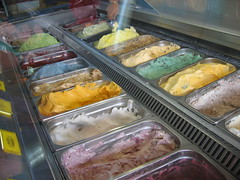Ice cream summer
10 March 2007
7:00 AM
This is the third in a series of articles on Chilean culture.
When the Chilean summer sun shines on you, if you pay attention, you can actually feel your skin burning. It’s not just the heat, but the sheer intensity. Temperatures are generally in the 80s and 90s, but it feels like each photon carries its own personal flame thrower to torch your body. Perhaps it has something to do with the UV radiation. Every day the newspaper reports the UV Index on an 11-point scale. Santiago is always at “9-10 Very Dangerous” or “11 Extremely Dangerous.”
The heat is exacerbated by the absence of any cooling. I don’t know of a house around me that has air conditioning. Many people don’t bother with fans either. Why push around the hot air? I suspect they’d say. Adobe houses help the matter, but you can only ask so much of your dirt walls. By mid-afternoon the heat has penetrated the house and left even the houseflies in a lethargic daze. This is the reason that the entire country migrates 80 miles west during the summer months. People abandon the city and countryside for their sliver of beach along Chile’s 3000-mile coastline.
Those without access to the beach aren’t left out, though, because Chileans’ primary tool for summer survival is more economical. We don’t need no stinkin’ fans—here we use ice cream. In order to stay cool, you have to eat a few each day. For best effect, try combining types: a giant scoop of ice cream will cool you, but it will leave you parched; best to follow up with a water-based pineapple popsicle. I wouldn’t be surprised if the country gained a collective 30 million pounds during the summer from ice cream alone. Maybe I’m exaggerating—I’m just saying it wouldn’t shock me.
Cost is low and access is omnipresent. You can get a decent popsicle for 18 cents. A soft-serve cone will set you back 45 cents. High quality Italian-style gelato is $1.10. On almost any given city block there will be a minimum of two stands selling some kind of pre-packaged ice cream. Within a one-block radius of the Los Andes plaza there are 24 locales where ice cream is available. Seventeen sell popsicles or other pre-packaged ice cream bars; four sell scoops of ice cream, three have soft-serve, and two offer premium gelato. One is an internet cafe, another is a video store, and two are haircut shops that offer a free popsicle with a children’s cut.
If this isn’t enough, the ice cream will come to you. During the summer, vendors carry small coolers of popsicles and board city buses to bring frozen heat management directly to you, the consumer. As the bus stops a man gets on and passes through the aisle announcing, “Piña piña, frambuesa frambuesa, chocolate, helados, heladitos a cien.” He has pineapple, raspberry, and chocolate, yours for just 100 pesos. Children and adults alike fish coins from their pockets and cool down with a popsicle.
Ice cream availability is a boon for those in parenting roles as well. One afternoon I took five girls from the foster home on a walk around town. For the affordable price of $1.80, I stopped all complaining and changed the topic of conversation to our chocolate popsicles. That’s money well spent.
Now that we’re at the beginning of March, people have returned from the beach to start work again. Before much longer, the days will be shorter, the weather most crisp, and the roving popsicle vendors will exchange their coolers for boxes of peanuts and candy. For now, the heat is still on. Wanna stay cool? Get a scoop and get on the bus.



Comments